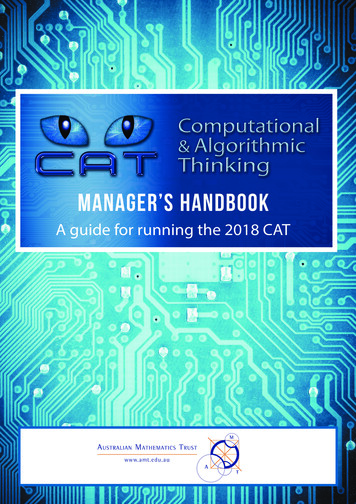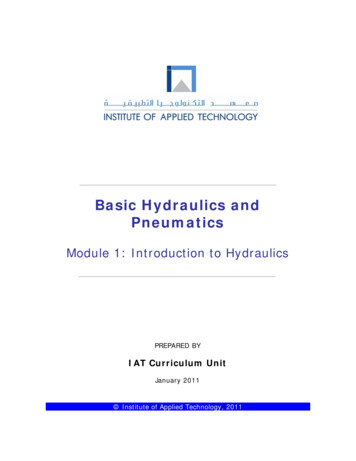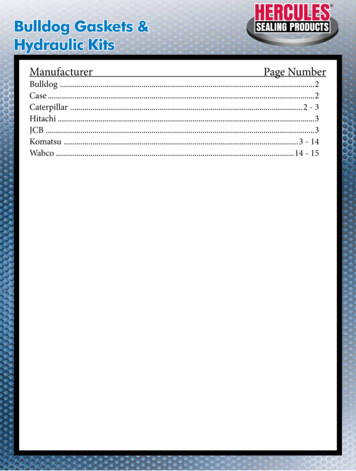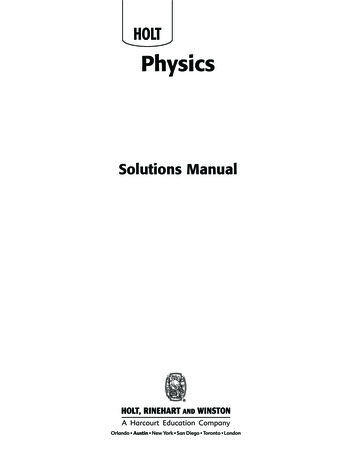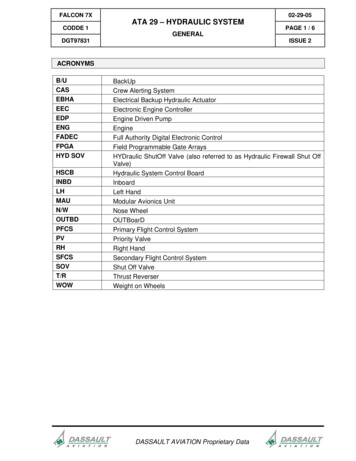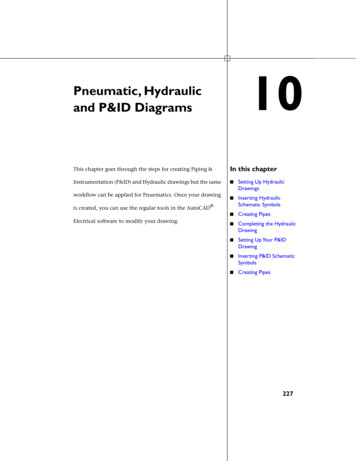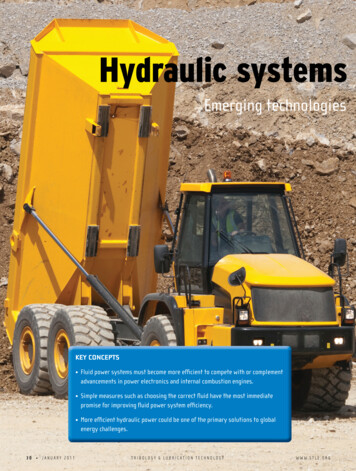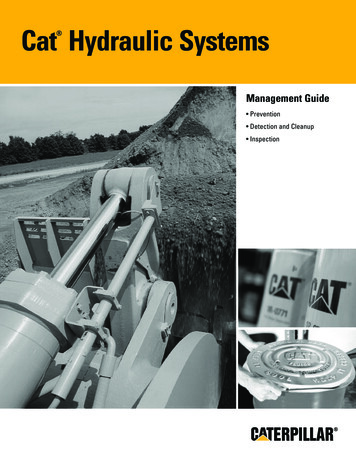
Transcription
Cat Hydraulic Systems Management Guide Prevention Detection and Cleanup Inspection
ContentsElements of hydraulic systems management .3PreventionKnow what contaminants are .4Know the effects of contamination .5Know when your systems are exposed to contamination .6Control contamination during housekeeping.7Control contamination during oil and filter changes and oil storage.8Control contamination during hose assembly .8Control contamination during general maintenance.10Control contamination during equipment operation.11Detection/CleanupKnow what is happening inside your hydraulic systems .12Understand our S·O·SSM Services.12Use the correct method to take samples .13InspectionRecommended service intervals .14Custom Hydraulic Service.14Repair indicators.152
Elements of hydraulicsystems y hydraulic system problems can beprevented with attention to the system’snumber-one enemy: fluid contamination.By learning to control contamination, youcan help maintain system efficiency,extend component life and correctproblems before they lead to costlyrepairs and unscheduled downtime.Hydraulic systems are closed systems,which means much of what you need toknow is happening internally. To detectwear and other problems that can occurinside the system, we recommend regularuse of our S·O·SSM Fluid Analysis Services.One of these services, Particle Counting,is especially important for hydraulics. Itidentifies excessive contamination levelsthat can be brought under control throughhigh-efficiency filtration, “kidney looping”and other means.Daily hydraulic system inspectionsperformed by you and your operators cancatch leaks and other small problemsbefore they result in unscheduleddowntime. Efficiency loss is not easilydetected and silently robs your machineof performance. That’s why we alsorecommend technical inspectionsperformed by our trained technicians.These periodic inspections includechecks of system pressures, cycletimes and more—which can identifyproblems and help us recommendcorrective actions.
PreventionKnow what contaminants arePreventing hydraulic system problems begins by addressing fluid contamination.Contaminated oil is the primary threat to today’s hydraulic systems. Understanding whatcontamination is, why it’s harmful, how it gets in and how to control it can go a long wayin improving machine performance, extending component life and lowering your costs.Contamination is anything foreign in the hydraulic system. There are two types ofcontaminants: particulate and chemical.4Particulate contaminantsChemical contaminantsParticulate contaminants are the mostcommon, measurable and controllable. Theycan be built in at the factory, transferred inthrough new oil, generated internally or takenin during maintenance, attachment changesand machine operation. Examples ofparticulate contaminants include dirt, sand,paint and metal or rubber wear particles.Chemical contaminants include heat, waterand air. These combine to break down theoil’s chemical composition, producingcontamination in the form of oxidation andacids. Like particulate contaminants,chemical contaminants can originate insideor outside the system.
PreventionAbrasive wearKnow the effects of contaminationFluid contamination damages a hydraulic system in two ways.First, it reduces system efficiency. Machine productivity andefficient hydraulics go hand in hand. If a hydraulic system isn’tperforming at peak efficiency, it’s robbing the machine ofperformance. Efficiency losses usually occur slowly and canreach 16 percent to 20 percent before the operator detects aloss in performance. These “invisible” efficiency losses also canincrease fuel consumption.Contamination also accelerates component wear—75 percentto 85 percent of hydraulic pump, motor, cylinder and valvefailures can be traced to contamination. Due to the extremelysmall clearances in today’s hydraulic systems, even particlesyou cannot see can damage pumps, motors, cylinders andvalves in the form of abrasive, adhesive and fatigue wear.Abrasive particles scrape metal fromhydraulic components. Wear metal iscreated, multiplies and travels to other partsof the system to do more damage.Fatigue wearRepeated high-pressure stress loads causemetal to chip or break from components andcontaminate the hydraulic system.Cat HydraulicSystem ClearancesVisible to the eye5MICRONS3040Typical metal-to-metal clearances in Cat hydraulic systems are5-30 microns (one micron is one millionth of a meter). Therefore,even particles too small to see can do big damage.Human hair80Adhesive wear (Silting)Small particles build up on metal surfacesand clog the flow of fluids. The result isjamming and sticking of valves and reducedsystem efficiency.5
PreventionKnow when your systems areexposed to contaminationBecause contamination can have many sources throughout the life of a machine,controlling it must be a joint effort.Caterpillar is committed to shipping clean machines and components. As a result,in-plant process reviews and employee education are ongoing efforts. Caterpillar alsois working to educate its dealers and customers on ways to keep Cat products cleanonce they leave the factory.Let’s look closely at some of the things you can do to minimize contamination. You’ll besurprised how many are simply common sense.CaterpillarCat Dealer6
PreventionControl contamination during housekeepingIf you have a service shop, housekeeping is the best place to initiate contamination control. Each technicianneeds to understand the importance of contamination control and practice it daily. Here are some tips:Keep floors and workareas cleanSweeping floors daily and maintaininguncluttered work benches with surfacesthat won’t mar parts or add contaminantsare good ways to jump-start contaminationcontrol efforts.Put someone in chargeMaking someone responsible andaccountable for results will help ensurecontamination control becomes anongoing effort.Manage spills correctlyProtect work “in progress”Oil spills should be cleaned up promptlyand properly. Absorbent pads, mops andscrubbers are recommended overgranular methods that tend to pollute theair with contaminants.When possible and at the end ofeach shift, make sure in-processrepairs are protected from airbornecontaminants. Ask us about otherrepair processes that can beimplemented to control contamination.7
PreventionControl contamination during oil andfilter changes and oil storageSelect the right oilCat Hydraulic Oil contains the neededadditives, like oxidation and foam inhibitors,to help prevent contamination. It also has morethan twice as much zinc as standard industrialoils to provide maximum protection to pumps,motors, cylinders and valves. Be familiar withthe additives in your oil, and don’t compromisequality to save a small amount of money.Change oil regularly and always filter oilstored in bulkCaterpillar has extended the oil changeinterval for hydraulic systems to 4,000 hours,providing certain conditions for monitoring theoil are met. We also recommend changing oilwhen it’s warm and agitated, and alwaysfiltering new oil from barrels or other bulksystems before installation.Control contaminationduring hose assemblyPrecautions you take when assembling and storing hosescan go a long way in minimizing fluid contamination.8Use tight-fitting barrel coversTight-fitting covers, such as our 1U6156, canhelp prevent dirt, water, airborne particles andother contaminants from entering oil barrels.It’s also wise to store barrels inside.
PreventionBesides maintaining a clean facility, paying attention to the hydraulic oil is important.The oil you select and how you store and transfer it all have an impact oncontamination and component life. Filter and fluid changes also present contaminationcontrol opportunities. Here are a few tips:Change filters regularlyand carefullyUse quality filters betweensystem invasionsUse High Efficiency Filters aftermaintenance and serviceHydraulic filters should be changed at leastevery 500 hours. It’s also important to keepnew filters and other parts packaged untilthey’re ready to install and to remove oldfilters carefully.Using inadequate filters can compromiseperformance. To maintain the highest levels ofcleanliness and performance, we recommendinstalling genuine Cat Fluid Filters.Contaminants invade the hydraulic system anytime it’s open for maintenance or repair. Werecommend Cat High Efficiency Filters at 250service meter hours following any systeminvasion. Be sure to change High EfficiencyFilters before 250 hours if the bypass indicatorgoes on.Clean hoses properly during assemblyThe cutting and assembly of hoses introduce many contaminants that need to be removedbefore installation. We recommend use of the Cat Hose Cleaner Group, which fires a foamprojectile through hoses, tubes and couplings. This air-powered tool takes only seconds tostrip out metal and rubber contaminants traditional cleaning methods leave behind.Protect stored hose and assembliesBulk hose in storage and assemblies that have been properly cleaned should be protectedfrom airborne contaminants. Installation of caps and plugs is a low-cost means of deliveringthis protection.9
PreventionControlcontaminationduring generalmaintenancePerform daily inspectionsWhen performing the daily inspections,check for leaks and promptly fix any youfind. Look especially for worn cylinderwiper seals and pitted rods that may begiving dirt and other contaminants a freepass into the system.Earlier we discussed the importance offollowing recommended oil and filterchange intervals. A few other preventiontips include:Keep hydraulic tanks filledAlways keep the hydraulic tank between“Full” and “Add.” Insufficient fluid levelsare the leading cause of pump cavitation,leading to pump failure and contaminationof the entire system. Low fluid levels canalso result in high oil temperatures,causing oil to degrade.Maintain valvesMaintain oil cooler and relief valvesproperly. Relief valve settings should beadjusted only by our trained technicians.If a pressure loss is detected, it’simportant to find its source and repair it.Replace worn fan beltsInspect fan belts, radiators and oilcoolers regularly. Maintaining fan speedand cleaning debris from radiators andoil coolers will help keep the systemoperating at acceptable temperatures.10
PreventionControl contamination duringequipment operationA variety of contaminants can be introduced into your hydraulic systemon the job site. Here are a few ways to guard against contamination:Monitor hydraulic system temperaturesExcessive heat in hydraulic systems thins the oil, increases fluid oxidation, bakes sealsand blisters hoses. It is important to monitor system temperatures and, if equipped, watchtemperature gauges and sensor lights.Use rod protectorsIn extremely dry applications and others where banked rock, corrosive material and debrisare common, we recommend protective covers for the exposed portions of hydraulic cylinderrods. Ask us for details.Use care when changing work toolsWith today’s machines, operators frequently change work tools that are hydraulically driven.If not maintained, these tools can contaminate each machine they’re attached to. Alwaysinspect quick couplers and wipe off dirt from flush-face disconnects before coupling. Protectnipples and couplers with caps and plugs.Listen to your operatorsAn often-overlooked opportunity for contamination control is listening to your operators. Dayin and day out, these individuals live with your machines and can alert you to excessive drift,noises and other signs of possible contamination.
Detection/CleanupKnow what is happeninginside your hydraulic systemsHelping to prevent contamination is important, but you also must know what isoccurring inside your hydraulic systems. Regular use of our S·O·S Services is the bestway to detect component wear and contamination so you can head off problems early.Take samples regularlyTaking hydraulic oil samples regularly—every 500 hours—is critical because itallows for accurate interpretation. When samples are taken regularly, a baseline isestablished so trends can emerge. We need this information to make proper servicerecommendations. How you take a sample is also important. For more information, askus to see video PEVN5514 (VHS tape) or AERV5514 (CD), both entitled “S·O·S ServicesOil Sampling Techniques.”The cleaner the system, the better!Caterpillar recommends a cleanliness target for optimizingcomponent life in Cat hydraulic systems of ISO 18/15 or cleaner.Understand our S·O·S ServicesSMS·O·S Services for hydraulic systems is composed of fourcomplementary tests: Component Wear Rate Analysis evaluates the wear takingplace inside the lubricated compartment. Oil Condition Analysis determines if the oil has degraded. Oil Contamination Tests determine if anything harmful hasentered the oil. Oil Identification confirms use of the correct oil.S·O·S interpreters use these tests to evaluate hydraulic systemhealth and, if needed, recommend maintenance.12
Detection/CleanupUse the correct method to take samplesUsing an oil valve probeFilling out label accuratelyUsing vacuum extraction Set the engine at low idle after it reachesnormal operating temperature. Remove thedust cap from the valve of the compartmentyou are sampling. Insert the probe into the valve and collectabout 100 ml (4 fl oz) of oil into a wastecontainer. Dispose of the waste oil andtube properly. Insert the probe with a new piece of tubeinto the valve again and fill the samplebottle about three-quarters full—do notfill to the top. Withdraw the probe and secure the capon the bottle. Place the bottle with thecompleted label into the shipping cylinder.Providing complete information on thesample label makes processing your sampleeasier. Make sure you include importantinformation like: Machine model and serial number Service meter units on equipment and oil Whether or not the oil was changed whenthe sample was taken Turn off the engine after it reaches normaloperating temperature. Measure and cutnew tubing to the length of the dipstick. Ifthe compartment you are sampling does nothave a dipstick, cut the tubing so that itreaches about halfway into the oil depth. Insert the tubing through the head of thevacuum pump and tighten the retaining nut.The tubing should extend about 4 cm (1 in)beyond the base of the vacuum pump head. Install a new sampling bottle onto thevacuum pump head and insert the end of thetubing into the oil—do not allow the tube totouch the bottom of the compartment. Pump the vacuum pump handle to create avacuum. Fill the bottle about three-quartersfull—do not fill to the top. Withdraw the tubing, remove the bottle fromthe vacuum pump and secure the cap on thebottle. Place the bottle with the completedlabel into the shipping cylinder.NOTE: Oil valve probe should be used onpressurized compartments only. Retrofit valvekits are available for models not equippedwith valves.Address elevated contamination levels promptlyWhen interpretation of S·O·S data verifies you have acontaminated system, it’s important to respond promptly. Thelonger you operate a contaminated system, the fastercomponents wear, system efficiency erodes and oil propertiesbreak down.Besides identifying and correcting the cause of elevatedcontamination levels, it’s important to clean up the system. HighEfficiency Filters, “kidney loop” filtration, oil changes or completesystem flushing may be appropriate, depending on contaminationlevels. We’ll be glad to discuss this topic and the Caterpillar FilterCarts available with you in more detail.13
InspectionFollow theserecommended hydraulicsystem service intervalsCall our servicedepartment for moreinformation on Custom10-hour or daily inspectionHydraulic Service and Check hydraulic fluid level Check hydraulic cylinders and pumpsfor leaks Check hoses, lines and hydraulic tankarea for leaks or damageto inquire about otherhydraulic systemmaintenance programsthat may be available.250-hour or monthly inspection Perform 10-hour preventivemaintenance checks Check hydraulic oil coolerfor leaks or plugging Check all hydraulic lines for damaged,missing or loose connections500-hour or quarterly inspection Perform 10- and 250-hour preventivemaintenance checks Perform S·O·S Services of hydraulic oil Change hydraulic filter Check hydraulic pumps and mountingsfor loose or missing hardware1,000-hour or six-month inspection Perform 10-, 250- and 500-hour preventivemaintenance checks Check pump weep holes for leaks2,000-hour or annual inspection Perform 10-, 250-, 500- and 1,000-hourpreventive maintenance checks Check hydraulic system pressure Check hydraulic system cycle times anddrift ratesThe final element in hydraulic system management involves inspecting and“listening to” your equipment. You can help maintain system performance andcatch problems early by: Following the inspection and maintenance schedule shown on this page Enrolling hydraulics-intensive machines in our Custom Hydraulic Service Program Paying attention to the repair indicators listed on page 15Custom Hydraulic Service (CHS)Once a year or every 2,000 hours, we recommend having your hydraulic systemsinspected by our trained service professionals. During these CHS inspections we: Conduct a detailed visual walkaround inspection of the hydraulics, enginecompartment, cab, power train and ground engaging tools Drift test all hydraulic cylinders Perform complete checks of cycle times and system pressures Stall test the hydraulic system Take a sample of the hydraulic oil and perform S·O·S ServicesAfter interpreting the inspection and fluid analysis results, we’ll meet with you todeliver a complete report. If service is necessary, we’ll also provide a quote. Weoffer a variety of repair options and can help you decide on the one best for you.
InspectionPay attention to repair indicators!Repair IndicatorsPossible CausesCat Dealer Service OptionsLeaksSystem pressure too highScored or bent cylinder rodFailed or incorrect sealsImproperly torqued hose connectionWorn or damaged hoses, tubes and fittingsMissing guardsHose serviceThorough visual machine inspectionMaintenance and diagnostic servicesS·O·S ServicesCustom Hydraulic ServiceExcessive cylinder driftValve adjustment neededScored cylinderFailed seal or sealsScored valveContaminated oilIdentification and measurementDiagnostic servicesS·O·S ServicesCustom Hydraulic ServiceSlow cycle timesEngine performanceFaulty valveLow fluid levelWorn system componentsContaminated oilMachine measurements compared to specsDiagnostic servicesS·O·S ServicesCustom Hydraulic ServiceNoisy operationEngine performanceLow fluid levelRestriction in systemAerationWorn system componentsFaulty relief valveThorough visual machine inspectionS·O·S ServicesCustom Hydraulic ServiceSystem overheatingFaulty oil coolerLow fluid levelPlugged filterWorn system componentsFaulty relief valveWrong viscosity or contaminated oilRestriction in systemPoor operator habitsThorough visual machine inspectionMaintenance and diagnostic servicesS·O·S ServicesCustom Hydraulic ServiceLoose cylinder jointsWorn rod or cylinder eye/trunnionPoor lubricationImproper preventive maintenance scheduleComponent inspection/repairCustom Hydraulic ServiceBlisters or abrasions in hosePinhole leaks in liner materialPoor hose routingExternal damageSystem overheatingThorough visual machine inspectionHose serviceCustom Hydraulic ServiceExcessive hose movementImproper clamping or routing of hoseAeration/cavitationHose serviceS·O·S ServicesHigh levels of wear elements, dirt andother contaminants in oil will acceleratecomponent wear and erode system efficiencyPreventive maintenance schedule consultationCustom Hydraulic ServiceHigh service meter hoursTalk with us to determine what high-hourservice is appropriate for your systemsConsult with dealerCustom Hydraulic Service15
Comprehensive serviceand supportMore and more of your operating costs are tied to hydraulic systems.We are committed to helping you lower those costs—as well asmaximize efficiency, productivity and machine availability—throughongoing attention to contamination control and the other systemmanagement elements.Ask us how we can incorporate a hydraulic system managementprogram into a Customer Support Agreement to achieve these results.For more information about our hydraulic products and services, callus today or visit the Caterpillar website at www.cat.com.CAT DEALERS DEFINE WORLDCLASS PRODUCT SUPPORT.We offer you the right parts and servicesolutions, when and where you need them.The Cat Dealer network of highly trainedexperts keeps your entire fleet up and runningto maximize your equipment investment.PEGP6028-05www.cat.com 2007 Caterpillar All Rights Reserved Printed in USACAT, CATERPILLAR, their respective logos, “Caterpillar Yellow” and the POWER EDGE trade dress, as well ascorporate and product identity used herein, are trademarks of Caterpillar and may not be used without permission.
to 85 percent of hydraulic pump, motor, cylinder and valve failures can be traced to contamination. Due to the extremely small clearances in today’s hydraulic systems, even particles you cannot see can damage pumps, motors, cylinders and valves in the form of abrasive, adhesive and fatigu
